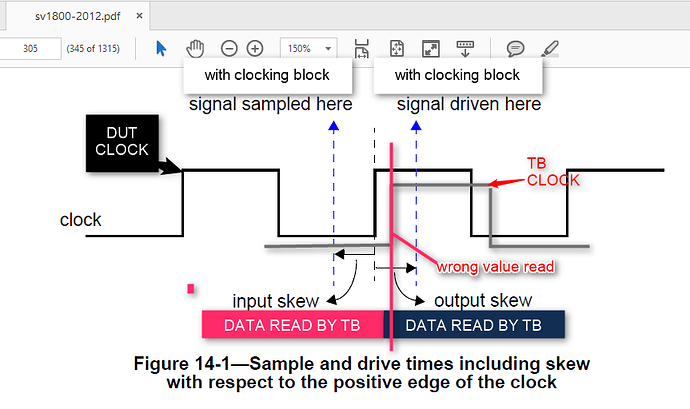In reply to rakesh2learn:
I am trying to understand how clocking block avoids the race condition between testbench(TB) and DUT. I am aware that clocking block construct introduces skews. But I can’t visualize how these skews avoid the race condition between TB and DUT. Can anyone elaborate with an example/scenario, to visualize this type of race condition in testbench? Thanks for your time in advance.
- 1) The clocking block enforces a time when signals are sampled. For example, assume a clock period of 10ns, and a clock jitter of 1ns between the testbench clock and the internal gate-level clock of the design. This uncertainty is caused by the internal delay of the DUT’s clock drivers and tree. (The 1 ns is excessive, but am using this number to make a point). That jitter can cause sampling problems, unless you can adjust the sampling time. Below is an annotated image of the problem, based on what is in 1800
-
- S similar argument can be made about inputs into the DUT
- 2)Clocking block, needed when driving into wires from tasks.The assign statement is illegal in classes. The reasons the clocking block works is exaplained in 1800. 1800-2012, section 14.3 Clocking block declaration states:
- A clockvar whose clocking direction is inout shall behave as if it were two clockvars, one input and one output, having the same name and the same clocking signal.
- Reading the value of such an inout clockvar shall be equivalent to reading the corresponding input clockvar.
- Writing to such an inout clockvar shall be equivalent to writing to the corresponding output clockvar
Ben Cohen
http://www.systemverilog.us/ ben@systemverilog.us
- SVA Handbook 4th Edition, 2016 ISBN 978-1518681448
- A Pragmatic Approach to VMM Adoption 2006 ISBN 0-9705394-9-5
- Using PSL/SUGAR for Formal and Dynamic Verification 2nd Edition, 2004, ISBN 0-9705394-6-0
- Real Chip Design and Verification Using Verilog and VHDL, 2002 isbn 0-9705394-2-8
- Component Design by Example ", 2001 ISBN 0-9705394-0-1
- VHDL Coding Styles and Methodologies, 2nd Edition, 1999 ISBN 0-7923-8474-1
- VHDL Answers to Frequently Asked Questions, 2nd Edition ISBN 0-7923-8115
